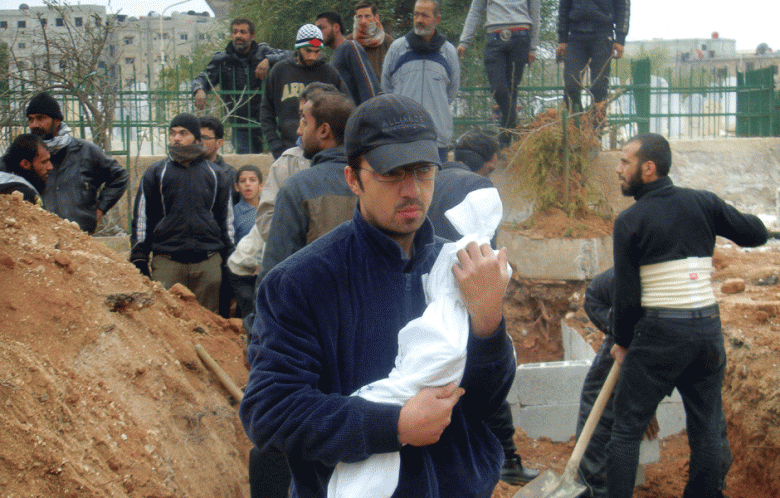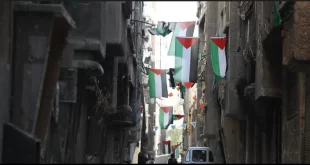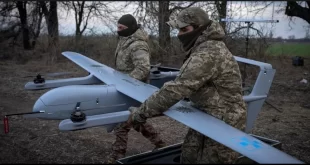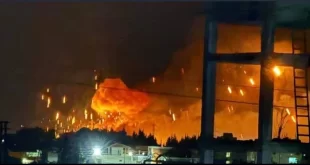
Feb 12, 2014, al Akhbar
The sheer devastation is enough for one to imagine what kind of battles have been taking place in the Yarmouk Palestinian refugee camp. There are no signs of life at the camp, except for the fighters of the Palestinian factions, who have filled the void left behind by the camp’s fleeing residents. In the opinion of the Palestinian fighters, the optimistic view that the crisis in the camp is over is rather exaggerated. To them, all talk about the neutrality of the camp in the armed conflict is just “empty words.”
Yarmouk — The traffic was thick on that sunny Damascus day, made worse by the checkpoints on both sides of the southern ring road leading to the Tadamun intersection and Batikha Square beyond it. Life appears normal, until one reaches the Yarmouk refugee camp.
We passed through two checkpoints manned by Fatah al-Intifada, a pro-regime Palestinian faction. A few meters later, we reached the neighborhood where Rawdat Zahrat al-Joulan, a school, is located. There are no students there, just fighters with their gear.
There are clear traces of shelling on the main gate of the school. A mortar has been deployed in the playground, but it has been “out of service” for a while, to make room for negotiations for a deal in the camp. Colonel Abu Iyyad from Fatah al-Intifada came out to greet us, along with a group of soldiers in fatigues, including several who were donning black uniforms with badges that had the word “counterterrorism” written on them.
The walls are covered with Palestinian and Syrian flags, and portraits of Syrian President Bashar al-Assad. Abu Iyyad explained the details of the agreement reached by the 14 Palestinian factions in the camp.
One of the demands, he said, was for al-Nusra Front and the Ibn Taymiyya Brigade to withdraw, which is indeed what happened on Tuesday, with the two groups withdrawing in the direction of Yalda. Abu Iyyad said, “Our decision is to retake the camp from the militants. We have made progress on the ground, causing confusion and divisions in their ranks.”
No doubt, the fighting here was very fierce over the last few months. The destruction all around, which becomes more pronounced as one goes deeper into the camp, bears witness to this.
At long last, an agreement was reached. Within four days the roads will be opened and all Palestinian factions will meet at Regie Square, the most important point in the center of the camp. The next step, according to Abu Iyyad, “if the initiative succeeds and we establish that outside militants have left the camp,” would be “for the rest of the militants, and us after them, to withdraw to al-Hajar al-Aswad.”
The Fatah al-Intifada colonel is optimistic. He said, “Within a month, life will be once again normal here, and the displaced persons would be able to return to their homes.” What about the devastation to the buildings and infrastructure caused by the fighting? Abu Iyyad said, “The destruction is at about 20 percent but the rest of the camp is intact. The municipality of Yarmouk will cooperate with the government to rebuild the camp.”
But it’s not just about damaged buildings or infrastructure. The humanitarian situation here is very dire, and the civilians have had to cope with incredibly difficult conditions. But Abu Iyyad stressed that the reports about the number of people who died of hunger were “grossly exaggerated.” He said, “We are of this people; others are just exploiting our blood,” adding, “They betrayed the Palestinian cause before they betrayed Syria.”
What about Hamas’s role in all what is happening, and its alleged ties to armed groups that took part in the fighting? Abu Iyyad says that “Hamas played a positive role with the factions that were working on finding a solution,” and denied that “Hamas members were fighting with the Ibn Taymiyya Brigade.”
He said that Hamas had links to the group called Aknaf Bayt al-Maqdis, but stopped short of confirming whether or not it had anything to do with events in the camp. However, one pro-regime fighter was not as reserved as Abu Iyyad, and declared without equivocation, “Even if Hamas did not participate officially, everyone knows they are fighting here.”
What About the Palestine Camp?
To get to the police station in the nearby Palestine Camp on foot, one has to cross “improvised” paths that the fighters had cleared between homes and buildings. There was no choice but to remain clear of the main road, because the risk of sniper fire still exists. Even ambulances have to take a different route to reach their patients.
Here too, there are no signs of life or civilians, only fighters and some reporters. Everyone has stuck to the buffer zone between Yarmouk Camp/al-Thalatheen Street, and the Palestine Camp.
Commander “Jeddo,” a 73-year-old man originally from Haifa, Palestine, and the “godfather” of the fighters here, is not optimistic at all. The same goes for his bodyguard and comrade Abu Salah.
“What happened is a truce, not a settlement,” he said. He added, “The Palestine camp and the Yarmouk camp are one and the same. Therefore, withdrawing from one but not the other is a ploy!” Jeddo says sharply, to the approval of those around him.’
He continued, “We have calmed things down, but we remain ready for anything.” Jeddo cannot be really said to be an old man. Neither his health nor his gait betrays it, although he was recently injured.
His son was killed in the fighting, but he nonetheless says that he will abide by the reconciliation. However, there is a lump in his throat. He said, “The initiative requires ending the hostilities in al-Thalatheen Street and Yarmouk. But what about the Palestine sector? This is all empty talk!”
One of the fighters manning the checkpoint along the line separating the two camps said, “I have been here for a year. Everyday, we hear that militants have withdrawn or that militants have entered.” “This camp cannot remain neutral from what is happening outside…let us not kid ourselves,” he added.
Jumaa al-Abdullah, a spokesperson for the Popular Front for the Liberation of Palestine-General Command (PFLP-GC), which supports the Syrian regime, was also there. Abdullah said, “The initiative will bear fruit after the militants vacate the points as agreed. We are still waiting for the militants of Ibn Taymiyyah to withdraw.”
Abdullah’s remarks support the view among the fighters of the PFLP-GC and Fatah al-Intifada who believe that the militants from the other side will not withdraw. One of them observed, “The coming days will prove that conditions here will not change much, especially that the 48-hour ultimatum given to the militants ends today.” So what do they think will happen? “A battle,” one answers.
On the other hand, Abdullah said, “The militants in the camp, as they saw that deals were being made elsewhere around them, have come to accept the facts on the ground.” Nevertheless, he continued, “The greatest challenge for the camp comes from surrounding areas, especially al-Hajar al-Aswad and Yalda,” where the fighting continues between the Syrian army and the militants.
In short: Yarmouk is in the end in Syria, and there can be no neutrality in the conflict there.
 Syria Support Movement solidarity with the Syrian people
Syria Support Movement solidarity with the Syrian people



